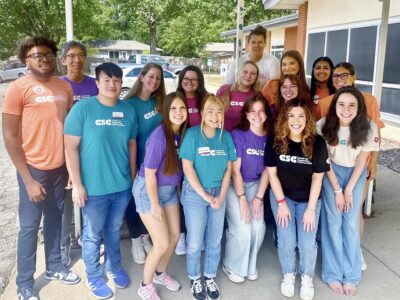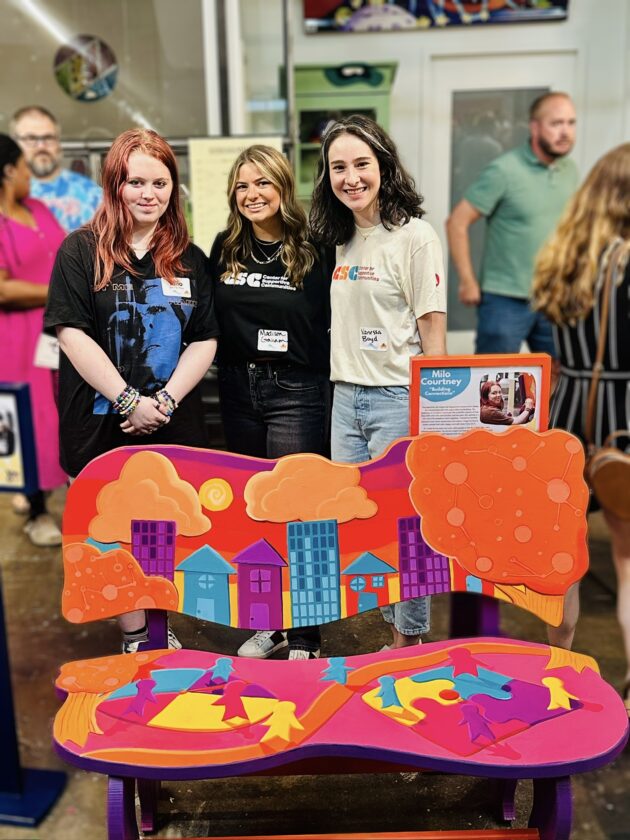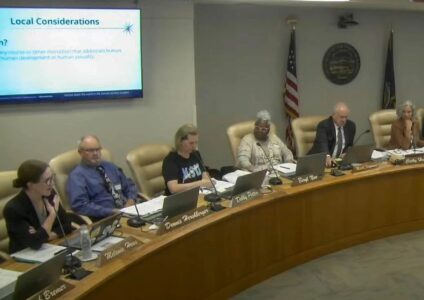Center for Supportive Communities rebuilds student ties with school by using mentorship to curb school district absenteeism

photo by: Contributed
The Center for Supportive Communities staff and mentors.
There are a variety of reasons a student might miss school, but if they miss too many days, becoming what’s referred to as “chronically absent” they could wind up in the court system for truancy. With chronic absenteeism lingering post-pandemic, the Center for Supportive Communities offers a court alternative that pairs truant students with mentors to rebuild their connection to school.
The center’s SupportEd program serves K-12 students and their families, with staff and volunteers working alongside the family and school to remove barriers, address student needs and increase school attendance.
Truancy cases among kids have increased as chronic absenteeism — defined as students missing 10% or more of school — emerged as a serious challenge during and continued after the COVID-19 pandemic. According to the U.S. Department of Education, the national rate of chronic absenteeism reached about 31% in the 2021-2022 school year and decreased to 28% in the 2022-23 school year. Meanwhile, leaders and volunteers of the CSC say truancy cases continue to be high in Douglas County schools.
“I think the issue of truancy is a major one and certainly has grown tremendously since the pandemic,” Irving Kuo, a SupportEd behavioral health mentor and licensed psychiatrist, said. “I don’t think we’ve really recovered from the pandemic in terms of getting kids back to school.”
In the 2024-2025 school year, the Center for Supportive Communities has served 73 families with 27 SupportEd mentors and 7,034 volunteer hours. The organization said 78% of students who completed the program have improved their overall attendance and 85% of students graduated with zero unexcused absences after one eight-week program with the center.
“When it came to going back to school (after the pandemic), we didn’t really transition anyone,” Kelsey Dachman, the group’s executive director and co-founder, said. “It was kind of like, yesterday you didn’t really need to go to school, and today we’re back to normal … I think parents just didn’t know what to do.”
The SupportEd program works by analyzing key data and information from the student, parent and school in order to identify the root causes of the student’s truancy. Dachman said that there are many reasons kids might avoid school. The program identifies the specific reasons behind their reluctance — whether it’s due to a challenging class or issues like bullying — and then creates an action plan to address the problem.

photo by: Contributed
Co-founders of Center for Supportive Communities Kelsey Dachman and Madison Graham.
“School isn’t positive for every kid, and it’s scary; people are mean,” Dachman said. “Kids are mean to each other and sometimes adults don’t know how to handle bullying that’s happening.”
Each student in the program is paired with an adult mentor who delivers targeted support through 1.5-hour weekly meetings. The mentors teach skills, help solve problems and offer academic and social support. Throughout the program, the center monitors the student’s progress by graphing weekly attendance and making intervention decisions, conducting weekly mental health checks and monitoring grades, behavior and program progress.
The CSC will eventually implement an individualized intervention to motivate the student to attend school and reinforce good behavior like school attendance and homework completion.
Kuo, the program mentor, who is turning 72 years old this year, retired after working as a psychiatrist back in 2022. He said that he became involved with the Center for Supportive Communities then, wanting to try something new and find a way to give back to the community.
Throughout his time at the center, he said he has enjoyed working with the kids in the SupportEd program. Kuo said each student he works with has a different story. For example, this year, he worked with a student he first met as an eighth grader and again later as a ninth grader going into Free State High School.
“He came from a really difficult background … and he had some successes initially, but then the summer intervened and he kind of regressed a lot,” Kuo said. “When I began to see him in ninth grade, it was to the point where he wasn’t really interested in connecting any longer, which was unfortunate.”
Kuo also worked with a middle school student just beginning sixth grade – and unlike the first child, had supportive parents – but “I think he had a lot of these social deficits that were really standing in the way.”
“Working with him was difficult, but we began to connect and he actually wound up graduating (the program and) went eight weeks without an absence,” Kuo said.
Kuo found that building real connections with students often began with simply taking the time to listen.
“I’m more interested in listening to them,” Kuo said. “I don’t know if kids have had the experience of an adult just paying attention to them and trying to understand where they’re coming from for an hour and a half each week.”
“(I’ve) been to the library quite a bit with both of these kids,” Kuo said. “I think the first child who really had not been to the library hardly at all was really interested in getting a library card. I think he was actually a pretty proficient reader, but they really didn’t have the opportunity to take out books and stuff like that, so that was really good for him.”
The idea of launching an initiative to tackle juvenile crime by addressing truancy started with Douglas County Judge Mike Elwell in 1977, where he focused on a program that would address truancy through school-based intervention. With support from University of Kansas students serving as mentors and tutors, the effort aimed to keep at-risk youth engaged in education.
A year later, KU Professor Jan B. Sheldon formalized the initiative into a practicum course — now known as the KU Truancy Prevention and Diversion Program — and it focused on incorporating evidence-based practices like family engagement, attendance monitoring and court collaboration.

photo by: Contributed
Co-founder of the CSC Madison Graham and Vanessa Boyd, operations manager of the CSC, stand with Van Go artist Milo Courtney. Courtney crafted a bench for the nonprofit as a part of the Van Go benchmark program.
Over the next four decades, the program expanded to elementary and middle schools, but it experienced funding cuts, leadership transitions and a global pandemic. KU decided to withdraw its support shortly after the beginning of the pandemic and in 2021, former program leaders – Dachman and Graham – founded the nonprofit Center for Supportive Communities and launched SupportEd.
“The fact that we’ve been able to continue (the program) for over 40 years and keep partnerships despite changes in legislation and who the leaders are, from the government, to the superintendent, to the director … the fact that we’ve been able to maintain those partnerships despite the regular turnover that we see I think is pretty incredible,” Dachman said.






